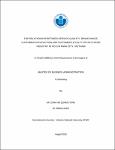| dc.contributor.author | Vinh, Dinh Ho Quang | |
| dc.date.accessioned | 2018-04-24T04:13:18Z | |
| dc.date.accessioned | 2018-05-28T09:07:23Z | |
| dc.date.available | 2018-04-24T04:13:18Z | |
| dc.date.available | 2018-05-28T09:07:23Z | |
| dc.date.issued | 2016 | |
| dc.identifier.other | 022003091 | |
| dc.identifier.uri | http://10.8.20.7:8080/xmlui/handle/123456789/2585 | |
| dc.description.abstract | Customer loyalty presents a paradox. Many see it as primarily an attitudebased
phenomenon that can be influenced significantly by Customer Relationship
Management initiatives such as the increasingly popular loyalty and affinity programs.
However, empirical research shows that loyalty in competitive repeat-purchase markets is
shaped more by the passive acceptance of brands than by strongly-held attitudes about
them. From this perspective, the demand- enhancing potential of loyalty programs is
more limited than might be hoped.
We review three different perspectives on loyalty, and relate these to a
framework for understanding customer loyalty that encompasses Service quality, Brand
image and Customer Satisfaction. This framework is used to analyze the demand-side
potential of loyalty programs. We discuss where these programs might work and where
they are unlikely to succeed on any large scale. A checklist for marketers is provided.
Keywords:
Customer relationship management; Customer loyalty; Service quality, Brand image;
Customer Satisfaction; Buyer behavior | en_US |
| dc.description.sponsorship | Ph.D. Le Nguyen Hau | en_US |
| dc.language.iso | en_US | en_US |
| dc.publisher | International University - HCMC | en_US |
| dc.subject | Brand equity | en_US |
| dc.title | The relationship between service quality, brand image, customer satisfaction and customer loyalty in fast foods industry in Ho Chi Minh City, Vietnam | en_US |
| dc.type | Thesis | en_US |


